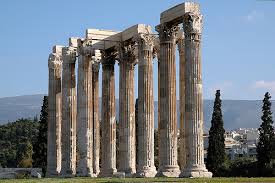More Culture Topics
- Ancient Greek Religion
- Greece Movie
- Greek Architecture
- Greek Art
- Greek Bible
- Greek Columns
- Greek Costumes
- Greek Culture
- Greek Jewellery
- Greek Key
- Greek Masks
- Greek Music
- Greek New Testament
- Greek Orthodox
- Greek Philosophers
- Greek Pottery
- Greek Radio
- Greek Religion
- Greek Sculpture
- Greek Tattoos
- Greek Temples
- Greek Theater
- Greek Tv
More Topic Categories
Related Destinations
Greek Columns
 In Ancient Greece, there were three orders of architecture, meaning three distinct types of buildings in terms of aesthetics and ornamental elements. The best way to distinguish among those types is to look at the columns of the buildings, which bear particularly evident differences.
In Ancient Greece, there were three orders of architecture, meaning three distinct types of buildings in terms of aesthetics and ornamental elements. The best way to distinguish among those types is to look at the columns of the buildings, which bear particularly evident differences.The three orders of architecture in Ancient Greece were the Doric, the Ionic and the Corinthian order. Although the Doric order is sometimes considered to precede the others chronologically, possibly due to its more austere aesthetics and bearing less ornamental elements, there is no evidence to support this; most probably, the Doric and the Ionic order evolved around the same time period, the former in mainland Greece and the latter in eastern Greece.
The Doric order was prevalent in mainland Greece and later spread to Sicily. It is the simplest of the three orders, with columns that have plain capitals without a base, and twenty flutes that run along the column’s height. A square abacus rests on the capital and supports the entablature, which has alternating triglyphs and metopes. The triglyphs have three vertical grooves and are centered above every column. An example of the Doric order is the Temple of the Delians, dedicated to god Apollo that is located in the island of Delos. The Temple of Hephaestus in Athens is also a distinctive Doric order building, while the Parthenon, even though it bears sculptural ornaments that are prevalent in the Ionic order, is also considered to be in the Doric order.
The Ionic order originated in eastern Greece and is characterized by fluted columns with a large base and two volutes, also called scrolls. There are 24 flutes in the column, four more than the ones in the Doric order. The entablature consists of three parts, one plain architrave, a highly ornamented frieze and a cornice. Examples of the Ionic order include the Temple of Hera on Samos island, the Temple of Artemis at Ephesus (which was one of the seven wonders of the Ancient World), as well as the Erechtheum on the Acropolis of Athens.
The Corinthian order is highly ornate, much more than the other two Greek orders. Main characteristics are a fluted column with an ornate capital, which has two rows of acanthus leaves and four volutes. There are also 24 flutes in the column, just like in the Ionic order. The oldest surviving example of the order is the Temple of Apollo Epicurius at Bassae, which is in Messinia. Another example is the Choragic Monument of Lysicrates in Athens. A Corinthian – order capital was excavated recently in Epidaurus and it is speculated that it was part of the Temple of Asclepius. It is now exhibited in the Archaeological Museum of Epidaurus.
The three Greek orders greatly influenced Roman architecture; in fact, Romans also developed two of their own, Tuscan and Composite, which were modifications of the Greek orders.
See Also:
 Athens Photos
Athens Photos
 Santorini Photos
Santorini Photos
 Crete Photos
Crete Photos
 Meteora Photos
Meteora Photos
 Corfu Photos
Corfu Photos





